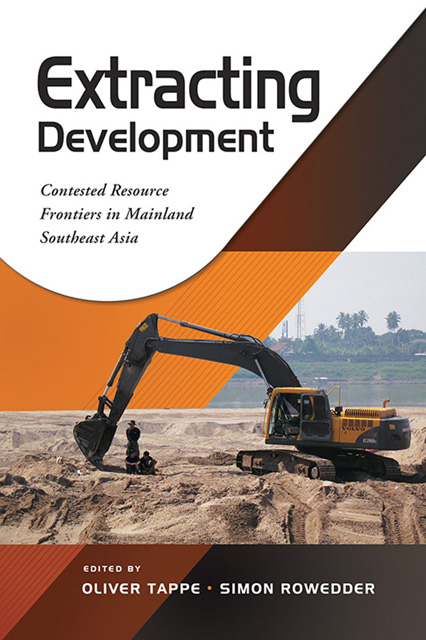Book contents
- Frontmatter
- Contents
- Acknowledgements
- The Contributors
- 1 Contested Resource Frontiers in Mainland Southeast Asia: An Introduction
- 2 Ontological Politics of the Resource Frontier: A Hydrosocial Analysis of the Mekong River in Northern Thailand
- 3 Reassembling Frontiers for Middle-Income Peasants: Rubber Expansion and Livelihood Ecosystem Transformation in a Northeast Thai Village
- 4 “Only the Best Fruits for China!”: Local Productions of a ‘Fruit Frontier’ in the Borderlands of China, Laos and Thailand
- 5 Commodity Frontiers in Motion: Tracing the Maize Boom across the Lao-Vietnamese Borderlands
- 6 New Frontier Spaces: Complex Entanglements and Power Relations (Re)shaping Land Governance in Laos
- 7 Moving Away from the Margins? How a Chinese Hydropower Project Made a Lao Community Modern and Comfortable
- 8 Frontier Capitalism in Colonial and Contemporary Laos: The Case of Tin Mining
- 9 Chinese Investments and Resource Frontiers in Cambodia: Systemic Transformation
- 10 The Open Issues: Cases between Chinese Investment Companies and Local People in Myanmar
- 11 Internationalization of RMB and Tin Ore Trade in China-Myanmar Frontier Governance: Views from Yunnan Province
- Index
1 - Contested Resource Frontiers in Mainland Southeast Asia: An Introduction
Published online by Cambridge University Press: 30 June 2023
- Frontmatter
- Contents
- Acknowledgements
- The Contributors
- 1 Contested Resource Frontiers in Mainland Southeast Asia: An Introduction
- 2 Ontological Politics of the Resource Frontier: A Hydrosocial Analysis of the Mekong River in Northern Thailand
- 3 Reassembling Frontiers for Middle-Income Peasants: Rubber Expansion and Livelihood Ecosystem Transformation in a Northeast Thai Village
- 4 “Only the Best Fruits for China!”: Local Productions of a ‘Fruit Frontier’ in the Borderlands of China, Laos and Thailand
- 5 Commodity Frontiers in Motion: Tracing the Maize Boom across the Lao-Vietnamese Borderlands
- 6 New Frontier Spaces: Complex Entanglements and Power Relations (Re)shaping Land Governance in Laos
- 7 Moving Away from the Margins? How a Chinese Hydropower Project Made a Lao Community Modern and Comfortable
- 8 Frontier Capitalism in Colonial and Contemporary Laos: The Case of Tin Mining
- 9 Chinese Investments and Resource Frontiers in Cambodia: Systemic Transformation
- 10 The Open Issues: Cases between Chinese Investment Companies and Local People in Myanmar
- 11 Internationalization of RMB and Tin Ore Trade in China-Myanmar Frontier Governance: Views from Yunnan Province
- Index
Summary
INTRODUCTION
Mainland Southeast Asia, the upland regions in particular, has a long history as contested reserve of valuable minerals and forest products. Moving along transregional trade networks—at times bones of contention between competing regional powers—these resources continue to shape present-day economic and political dynamics. While mining and logging remain contested fields of resource extraction, new resource frontiers emerge: Transboundary investments in land or water reserves reveal new tendencies of resource struggles in the region.
This edited volume investigates recent trends and issues of resource extraction in Mainland Southeast Asia and their effect on local economies and social relations. Case studies from different countries analyse the socio-political dimensions of natural and agrarian resources such as minerals, water, land and cash crops. Some contributions focus on the significance of China's resource hunger for these commodities, and how local communities in the region perceive the opportunities and risks of the Belt and Road Initiative (BRI). However, this volume also aims to shift the focus on competing actors of resource extraction and governance within Southeast Asia and the contingent outcomes of (and local responses to) transregional economic dynamics, political entanglements and related socio-ecological transformations.
Contemporary Southeast Asia offers manifold test cases to discuss how local “frontier assemblages” (Cons and Eilenberg 2019a) relate to different (overlapping) resource regimes, corresponding discourses and changing patterns of (hybrid) resource governance (Barney 2009; Dzüvichü and Baruah 2019; Kelly and Peluso 2015; Li 2014; Miller et al. 2020). This volume brings together contributions that (re)examine different local frontier configurations and dynamics across up- and lowland Southeast Asia from various disciplinary vantage points. Providing an impressive breadth and depth of fresh empirical insights from the region, conceptually enriched by an intriguing combination of different disciplines and scales of analysis, this collection importantly highlights the complexity and diversity of actors involved. It foregrounds their intricately linked, often contesting and conflicting but sometimes surprisingly converging, interests in imagining, co-producing or challenging new frontiers of infrastructural development, resource extraction and land commoditization.
This multifaceted attention to complexity is much needed to address the ubiquitously cited rise of China's geopolitical and economic influence in Southeast Asia, most prominently expressed in the BRI (Chong and Pham 2020; Sidaway et al. 2020; Mierzejewski 2021).
Information
- Type
- Chapter
- Information
- Extracting DevelopmentContested Resource Frontiers in Mainland Southeast Asia, pp. 1 - 27Publisher: ISEAS–Yusof Ishak InstitutePrint publication year: 2022
